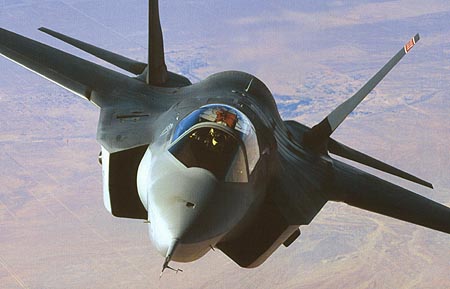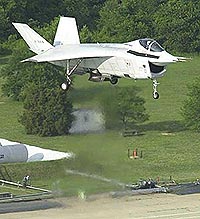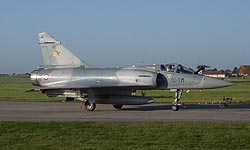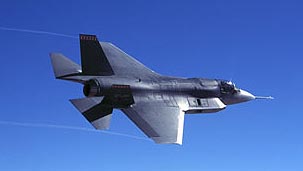 Beauty
or Beast…?
Beauty
or Beast…?
Now that the pantomime season is upon us, Tom McGhee looks at some of the ugly sisters of the air. All pictures by the author unless stated otherwise.
In what has been touted as the largest military aircraft contract ever, the winner of the Joint Strike Fighter contest was revealed to be the Lockheed Martin X-35 (left). When finally put into production, this aircraft is slated to replace thousands of F-16, F-18, AV-8, Harrier and Sea Harrier aircraft with numerous air arms throughout the world.
A fly-off
evaluation against the Boeing X-32 (right) was completed during
the course of 2001 and the two designs were found to be very comparable
in most respects, and so it came as  something
of a surprise when the Lockheed design was deemed to be the superior product.
Sources close to the decision making process have revealed that the factor
which tipped the balance against the Boeing product was its "sheer
ugliness" when compared against the graceful Lockheed design. "We're
fed up of our potential adversaries laughing at our hardware" claimed
General Madeup when quizzed about the decision. "It's about time
we had good-looking kit for our flyboys".
something
of a surprise when the Lockheed design was deemed to be the superior product.
Sources close to the decision making process have revealed that the factor
which tipped the balance against the Boeing product was its "sheer
ugliness" when compared against the graceful Lockheed design. "We're
fed up of our potential adversaries laughing at our hardware" claimed
General Madeup when quizzed about the decision. "It's about time
we had good-looking kit for our flyboys".
 Looking
back to past Pentagon aircraft procurement decisions shows that the General
may well have a point, as some truly hideous designs have managed to make
their way into squadron service. Probably the most obvious was the 1970s
fly-off competition for a Close Air Support aircraft, a competition blessed
with two unsightly designs in the Northrop YA-9 and Fairchild YA-10. The
"distinctive" Fairchild design was chosen to be the most suitable,
however, despite the USAF eventually coming up with an official name of
Thunderbolt II, it is still universally known as the 'Warthog' (above
left).
Looking
back to past Pentagon aircraft procurement decisions shows that the General
may well have a point, as some truly hideous designs have managed to make
their way into squadron service. Probably the most obvious was the 1970s
fly-off competition for a Close Air Support aircraft, a competition blessed
with two unsightly designs in the Northrop YA-9 and Fairchild YA-10. The
"distinctive" Fairchild design was chosen to be the most suitable,
however, despite the USAF eventually coming up with an official name of
Thunderbolt II, it is still universally known as the 'Warthog' (above
left).
 Another
ground attack aircraft was the LTV
A-7 Corsair II, a pugnacious development of the US Navy's sleek F-8
Crusader (right). The A-7 was quickly given a nickname of SLUF
(Short, Little, Ugly Fella) and proves that it is extremely easy to make
a pig's ear out of a silk purse.
Another
ground attack aircraft was the LTV
A-7 Corsair II, a pugnacious development of the US Navy's sleek F-8
Crusader (right). The A-7 was quickly given a nickname of SLUF
(Short, Little, Ugly Fella) and proves that it is extremely easy to make
a pig's ear out of a silk purse.
 Aesthetic
appearance was never given much thought in the early flying days, as it
was hard enough to get anything into the air, however as manufacturers
managed to get more used to production techniques a modicum of style was
gradually introduced, and the first truly beautiful fighter appeared in
the shape of Supermarine's elegant Spitfire.
This heralded the beginning of a period of British aviation design supremacy,
epitomised by the stunning Hawker Hunter.
However, in conjunction with the 1960s' decline in British aviation manufacturers,
came
Aesthetic
appearance was never given much thought in the early flying days, as it
was hard enough to get anything into the air, however as manufacturers
managed to get more used to production techniques a modicum of style was
gradually introduced, and the first truly beautiful fighter appeared in
the shape of Supermarine's elegant Spitfire.
This heralded the beginning of a period of British aviation design supremacy,
epitomised by the stunning Hawker Hunter.
However, in conjunction with the 1960s' decline in British aviation manufacturers,
came  a
decline in style, typified by Blackburn's pug-ugly area-ruled Buccaneer.
Even the more recent British designs like Tornado
(with a totally out-of-scale vertical tail fin) and the Eurofighter
are just workmanlike designs, and in recent years it has been the French
who have taken up the mantle of aviation styling from the British. Their
Rafale is infinitely
more stylish than the Eurofighter, and their previous Mirage F1 (right)
and Mirage 2000 (above left) designs have had a fair degree of
elegance.
a
decline in style, typified by Blackburn's pug-ugly area-ruled Buccaneer.
Even the more recent British designs like Tornado
(with a totally out-of-scale vertical tail fin) and the Eurofighter
are just workmanlike designs, and in recent years it has been the French
who have taken up the mantle of aviation styling from the British. Their
Rafale is infinitely
more stylish than the Eurofighter, and their previous Mirage F1 (right)
and Mirage 2000 (above left) designs have had a fair degree of
elegance.
 But
at last it appears that the Americans have finally started to get it right,
their previous fly-off competition also resulted in Lockheed's sleek F-22
being selected over Northrop's strangely elongated F-23 (left)
in the search for an F-15
replacement. So in the future maybe we can look forward to seeing less
grotesque designs like F-117
and AH-64, and more generic
sleek designs based on stealth requirements - but, if JSF is last of the
mass-produced fighters, it might be a bit boring really!
But
at last it appears that the Americans have finally started to get it right,
their previous fly-off competition also resulted in Lockheed's sleek F-22
being selected over Northrop's strangely elongated F-23 (left)
in the search for an F-15
replacement. So in the future maybe we can look forward to seeing less
grotesque designs like F-117
and AH-64, and more generic
sleek designs based on stealth requirements - but, if JSF is last of the
mass-produced fighters, it might be a bit boring really!

